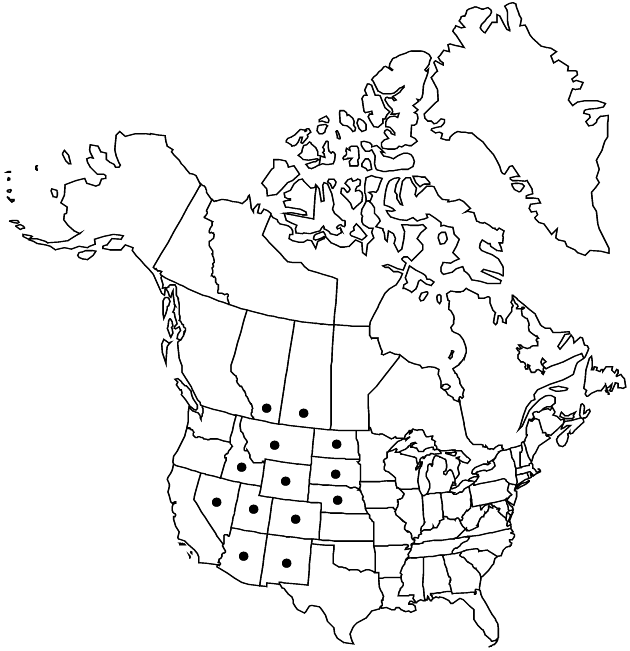Difference between revisions of "Xanthisma grindelioides"
Sida 20: 1403. 2003.
FNA>Volume Importer |
RevisionBot (talk | contribs) m (Bot: Adding category Revised Since Print) |
||
| (4 intermediate revisions by 3 users not shown) | |||
| Line 8: | Line 8: | ||
}} | }} | ||
|common_names=Goldenweed;gumweed aster | |common_names=Goldenweed;gumweed aster | ||
| + | |special_status={{Treatment/ID/Special_status | ||
| + | |code=E | ||
| + | |label=Endemic | ||
| + | }} | ||
|basionyms={{Treatment/ID/Basionym | |basionyms={{Treatment/ID/Basionym | ||
|name=Eriocarpum grindelioides | |name=Eriocarpum grindelioides | ||
| Line 34: | Line 38: | ||
-->{{Treatment/Body | -->{{Treatment/Body | ||
| − | |distribution= | + | |distribution=Alta.;Sask.;Ariz.;Colo.;Idaho;Mont.;N.Dak.;N.Mex.;Nebr.;Nev.;S.Dak.;Utah;Wyo. |
|discussion=<p>Varieties 2 (2 in the flora).</p> | |discussion=<p>Varieties 2 (2 in the flora).</p> | ||
|tables= | |tables= | ||
| Line 64: | Line 68: | ||
|basionyms=Eriocarpum grindelioides | |basionyms=Eriocarpum grindelioides | ||
|family=Asteraceae | |family=Asteraceae | ||
| − | |distribution= | + | |distribution=Alta.;Sask.;Ariz.;Colo.;Idaho;Mont.;N.Dak.;N.Mex.;Nebr.;Nev.;S.Dak.;Utah;Wyo. |
|reference=None | |reference=None | ||
|publication title=Sida | |publication title=Sida | ||
|publication year=2003 | |publication year=2003 | ||
| − | |special status= | + | |special status=Endemic |
| − | |source xml=https:// | + | |source xml=https://bitbucket.org/aafc-mbb/fna-data-curation/src/2e0870ddd59836b60bcf96646a41e87ea5a5943a/coarse_grained_fna_xml/V19-20-21/V20_882.xml |
|tribe=Asteraceae tribe Astereae | |tribe=Asteraceae tribe Astereae | ||
|genus=Xanthisma | |genus=Xanthisma | ||
| Line 76: | Line 80: | ||
}}<!-- | }}<!-- | ||
| − | -->[[Category:Treatment]][[Category:Xanthisma sect. Blepharodon]] | + | --> |
| + | |||
| + | [[Category:Treatment]] | ||
| + | [[Category:Xanthisma sect. Blepharodon]] | ||
| + | [[Category:Revised Since Print]] | ||
Latest revision as of 18:31, 6 November 2020
Subshrubs, 3–35 cm (tufted or densely cespitose, often mound-forming); caudices much branched, taproot 2–20+ cm. Stems 10–30+, simple or branched in distal 1/3, moderately stout to stout, not wiry, hairy or minutely stipitate-glandular. Leaves: basal often persistent; cauline evenly spaced, blades oblong, obovate, lanceolate to spatulate or narrowly ovate to obovate, 7–60 × 2–13 mm, gradually reduced distally, margins usually evenly coarsely serrate to serrulate, teeth 4–16 per side, each tipped with white bristle 0.5–4 mm, faces sparsely to densely hairy (hairs subappressed), often minutely stipitate-glandular. Heads 1–10+. Peduncles sparsely to densely hairy, often stipitate-glandular; sometimes bracteate. Involucres hemispheric to campanulate, 0.5–1 × 0.6–1.5 cm. Phyllaries in 3–5 series, oblong to broadly lanceolate, 2–9 mm, apices obtuse to acute, tipped by white seta, faces usually densely stipitate-glandular. Ray florets 0. Disc florets 15–50+; corollas 5–8.5 mm. Cypselae oblong to narrowly obovoid, 2–3.5 mm, ribs 12–24, densely whitish to tawny hairy; pappi whitish to tawny, 3–7 mm, a few abaxial bristles to 1/3 of longest.
Distribution

Alta., Sask., Ariz., Colo., Idaho, Mont., N.Dak., N.Mex., Nebr., Nev., S.Dak., Utah, Wyo.
Discussion
Varieties 2 (2 in the flora).
Selected References
None.
Key
| 1 | Plants tufted, 10–35 cm; leaves evenly distributed along stems, margins usually ciliate, sometimes spinulose-dentate, bristles usually 0.5–1.5 mm; heads 1 or often 2–5; peduncles 0.5–2 cm, often bracteate to proximal to heads | Xanthisma grindelioides var. grindeloides |
| 1 | Plants densely cespitose, mostly 3–8 cm; leaves mostly crowded at base of stem, margins conspicuously white-bristled (1.5–)2–4 mm; heads usually 1; peduncles 1–4 cm, usually ebracteate | Xanthisma grindelioides var. depressum |